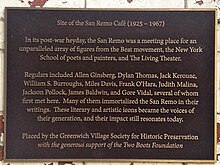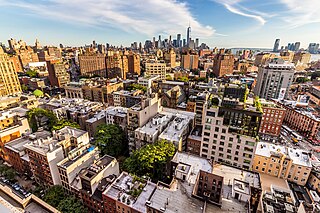
Greenwich Village, or simply the Village, is a neighborhood on the west side of Lower Manhattan in New York City, bounded by 14th Street to the north, Broadway to the east, Houston Street to the south, and the Hudson River to the west. Greenwich Village also contains several subsections, including the West Village west of Seventh Avenue and the Meatpacking District in the northwest corner of Greenwich Village.

The Beat Generation was a literary subculture movement started by a group of authors whose work explored and influenced American culture and politics in the post-World War II era. The bulk of their work was published and popularized by Silent Generationers in the 1950s, better known as Beatniks. The central elements of Beat culture are the rejection of standard narrative values, making a spiritual quest, the exploration of American and Eastern religions, the rejection of economic materialism, explicit portrayals of the human condition, experimentation with psychedelic drugs, and sexual liberation and exploration.

The Subterraneans is a 1958 novella by the Beat Generation author Jack Kerouac. It is a semi-fictional account of his short romance with Alene Lee (1931–1991), an African-American woman, in Greenwich Village, New York. It was the first work of Kerouac’s to be released following the success of On the Road. The Subterraneans and its following novel,The Dharma Bums, both proved to be popular when released in 1958, and are now seen as important works of the Beat Literature. A Hollywood film adaptation would be released in 1960.

The Cornelia Street Cafe, was a restaurant & bar at 29 Cornelia Street in New York City's Greenwich Village, opened in July 1977. The cafe closed at the end of 2018, due to rising rents from the gentrification of the West Village; ending on its holiday closed day of New Years 2019. The cafe had been voted one of the best places to listen to jazz music in the world.

The Gaslight Cafe was a coffeehouse in the Greenwich Village neighborhood of Manhattan, New York. Also known as The Village Gaslight, it opened in 1958 and became notable as a venue for folk music and other musical acts. It closed in 1971.

4th Street is a street in Lower Manhattan, New York City. It starts at Avenue D as East 4th Street and continues to Broadway, where it becomes West 4th Street. It continues west until the Avenue of the Americas, where West 4th Street turns north and confusingly intersects with West 10th, 11th, 12th, and 13th Streets in Greenwich Village. Most of the street has the same 40-foot (12 m) width between curbstones as others in the prevailing street grid, striped as two curbside lanes and one traffic lane, with one-way traffic eastbound. The portion from Seventh to Eighth Avenues is westbound and is approximately 35 feet (11 m) wide, a legacy of the original Greenwich Village street grid. The section of four short blocks from MacDougal Street to University Place which forms the southern border of Washington Square Park is called Washington Square South.
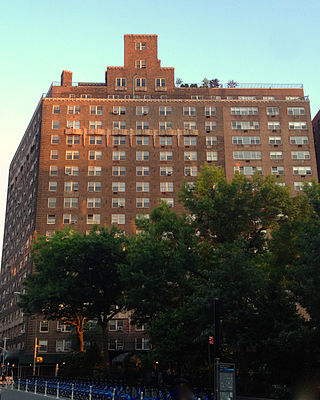
The West Village is a neighborhood in the western section of the larger Greenwich Village neighborhood of Lower Manhattan, New York City. The West Village is bounded by the Hudson River to the west and 14th Street to the north. The eastern boundary is variously cited as Greenwich Avenue, Seventh Avenue, or Sixth Avenue, while the southern boundary is either Houston Street or Christopher Street.

The White Horse Tavern, located in New York City's borough of Manhattan at Hudson Street and 11th Street, is known for its 1950s and 1960s bohemian culture. It is one of the few major gathering-places for writers and artists from this period in Greenwich Village that remains open. The bar opened in 1880 but was more a longshoremen's bar than a literary center until Dylan Thomas and other writers began frequenting it in the early 1950s. Because of its literary fame, the White Horse has become popular with tourists.

Weehawken Street is a short street located in New York City's West Village, in the borough of Manhattan, one block from and parallel to West and Washington Streets, running between Christopher Street and West 10th Street. It takes name from a colonial-era ferry landing and connection across the Hudson River to Weehawken, New Jersey.

The Whitney Museum of American Art's original building is a collection of three 1838 rowhouses at 8–12 West 8th Street, between Fifth Avenue and MacDougal Street, in the Greenwich Village neighborhood of Manhattan in New York City. In 1907, Gertrude Vanderbilt Whitney established the Whitney Studio Gallery at 8 West 8th Street adjacent to her own MacDougal Alley studio. This, and the later Whitney Studio Club at 147 West 4th Street, were intended to provide young artists with places to meet and exhibit their works.

MacDougal Street is a one-way street in the Greenwich Village and SoHo neighborhoods of Manhattan, New York City. The street is bounded on the south by Prince Street and on the north by West 8th Street; its numbering begins in the south. Between Waverly Place and West 3rd Street it carries the name Washington Square West and the numbering scheme changes, running north to south, beginning with #29 Washington Square West at Waverly Place and ending at #37 at West 3rd Street. Traffic on the street runs southbound (downtown).

Julius' is a tavern at 159 West 10th Street and Waverly Place in the Greenwich Village neighborhood of Manhattan in New York City. It is often called the oldest continuously operating gay bar in New York City. Its management, however, was actively unwilling to operate as such, and harassed gay customers until 1966. The April 1966 "Sip-In" at Julius, located a block northeast of the Stonewall Inn, established the right of gay people to be served in licensed premises in New York. This action helped clear the way for gay premises with state liquor licenses.

The South Village is a largely residential area that is part of the larger Greenwich Village in Lower Manhattan, New York City, directly below Washington Square Park. Known for its immigrant heritage and bohemian history, the architecture of the South Village is primarily tenement-style apartment buildings, indicative of the area's history as an enclave for Italian-American immigrants and working-class residents of New York.

Caffe Reggio is a New York City coffeehouse first opened in 1927 at 119 Macdougal Street in the heart of Manhattan's Greenwich Village.
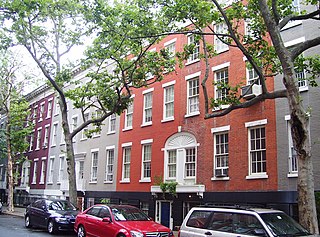
The MacDougal–Sullivan Gardens Historic District is a small historic district consisting of 22 houses located at 74–96 MacDougal Street and 170–188 Sullivan Street between Houston and Bleecker Streets in the South Village area of the Greenwich Village neighborhood of Manhattan, New York City.

The Hess triangle is a triangular tile mosaic set in a sidewalk in New York City's West Village neighborhood at the corner of Seventh Avenue and Christopher Street. The plaque reads "Property of the Hess Estate which has never been dedicated for public purposes." The plaque is an isosceles triangle, with a 25+1⁄2-inch (65 cm) base and 27+1⁄2-inch (70 cm) legs (sides).
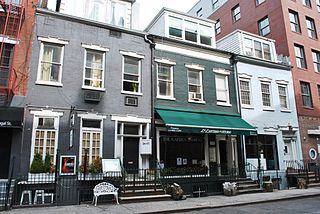
La Lanterna di Vittorio is a cafe and pizzeria at 129 MacDougal Street, Greenwich Village, New York City. The restaurant is situated in a restored townhouse and serves Italian cuisine. It is noted for its Bar Next Door room in the basement which hosts regular live jazz and rock performances. The basement is characterized by "low ceilings, and exposed brick and romantic lighting". In 2007, Jazz Education Journal referred to it as "One of NYC's great secrets for a first-class jazz experience." The Jonathan Kreisberg Trio are regular performers at the clubs on Wednesdays.

The Players Theatre, located at 115 MacDougal Street between West 3rd and Bleecker Streets in the West Village neighborhood of Manhattan, is one of the oldest commercial Off-Broadway theatres in operation in New York City. The Players Theatre contains a main stage with more than 200 seats and a 50-seat black box theatre, as well as four rehearsal rooms. The historic Cafe Wha? is located in its basement.

Eve's Hangout was a New York City lesbian nightclub established by Polish-Jewish feminist Eva Kotchever in Greenwich Village, Lower Manhattan, in 1925. The establishment was also known as "Eve Adams' Tearoom", a pun on the names Eve and Adam.
Kettle of Fish is a historic bar in Greenwich Village, Manhattan, New York City. The bar was opened in 1950 on MacDougal Street, but in 1987 it relocated to the former site of Gerde's Folk City, before moving again in 1999 to its current location on Christopher Street.
